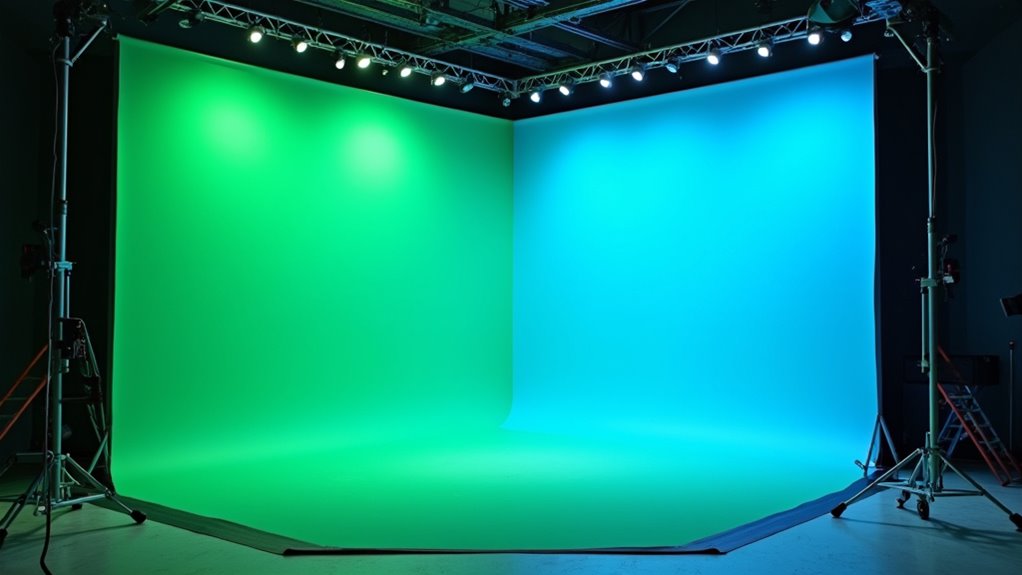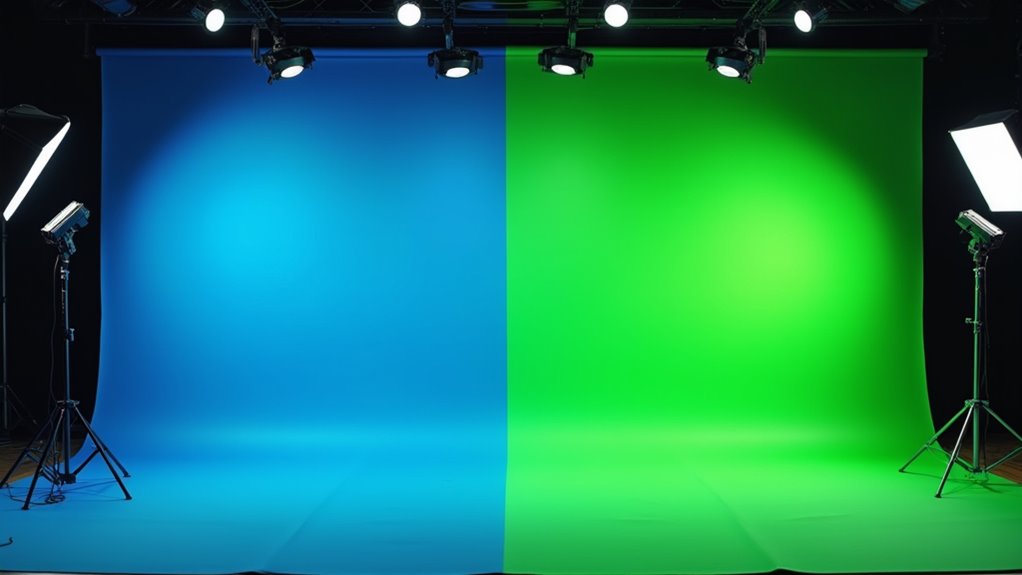Blue and green screens represent fundamental visual effects tools that allow filmmakers to transport actors into any conceivable environment through chroma keying technology. These distinctly colored backdrops serve as blank canvases, enabling post-production teams to digitally remove the solid color and replace it with new backgrounds, from alien worlds to historical settings. While green screens offer superior luminance for digital work, blue screens excel in low-light situations, giving productions flexible options for creating movie magic.
What Makes Blue and Green Screens Essential in Modern Filmmaking

While special effects have dramatically evolved since the early days of cinema, blue and green screens remain fundamental tools that have revolutionized modern filmmaking. These versatile technologies enable directors to create mind-bending worlds and impossible scenarios without breaking the bank, proving that sometimes the simplest solutions pack the biggest punch.
Through the magic of chroma keying, filmmakers can transport actors from a modest studio straight into alien landscapes, medieval battles, or even yesterday’s news broadcast. The technology works by isolating the actors from their bright monochromatic backdrop during filming. Green screens are particularly effective because they offer higher luminance for daytime scenes.
Chroma key technology turns any studio into a portal, whisking performers into fantastical worlds with just a colored backdrop.
The true genius of these screens lies in their universal application and cost-effectiveness, allowing productions of all sizes to punch above their weight class visually. Whether it’s a blockbuster superhero film or a local weather forecast, the technology democratizes special effects by providing endless creative possibilities.
Modern post-production software has only enhanced their utility, seamlessly blending real-world footage with digital elements in ways that would make Georges Méliès’s head spin.
Key Differences Between Blue and Green Screen Technology
Despite their similar roles in visual effects, blue and green screens serve distinct purposes that can make or break a production’s success. While both rely on chroma keying technology, their unique properties create different advantages in specific filming situations, much like choosing between a smartphone camera and a DSLR for various photography needs.
Green screens, the more luminous option, have become the go-to choice for digital productions, thanks to their superior performance with modern camera sensors and reduced noise during keying. Their brightness, however, can be both a blessing and a curse, potentially causing unwanted light spill in tighter shooting spaces. Digital cameras capture significantly more detail in green color ranges, making this option increasingly popular among filmmakers. Production designers must carefully avoid using green or blue in costumes and props to ensure successful compositing.
Blue screens, meanwhile, shine in low-light scenarios and night shoots, where their darker nature actually helps maintain the mood. They’re particularly valuable when filming scenes that require precise edge detail, though they demand more powerful lighting setups to achieve optimal results.
The choice between them often boils down to practical considerations like lighting budgets and costume colors.
Selecting the Right Screen Color for Your Production

How does a filmmaker choose between blue and green screens when both options seem equally viable? The decision hinges on several crucial factors that can make or break a production’s visual effects.
While green screens have become the go-to choice for digital productions, thanks to their superior luminosity and easier keying process, blue screens still hold their ground in specific scenarios. A director shooting a night scene might opt for blue screens, which require more lighting but create a more natural low-light ambiance. Digital productions also benefit from extensive color space control during post-production compositing. Modern filmmakers can enhance their chroma key effects through digital color grading that allows precise manipulation of shades and tones.
Green screens excel in digital work, but blue screens remain invaluable for night scenes where atmospheric darkness matters most.
Meanwhile, a production heavy on emerald wardrobes or verdant props would naturally gravitate toward blue to avoid color interference. The capture medium also plays a vital role – film productions often prefer blue screens for their lower grain and cleaner compositing, while digital cameras love the brightness of green screens, capturing more color information for smoother post-production work.
The choice ultimately boils down to the unique demands of each project.
Frequently Asked Questions
How Long Does It Take to Set up a Professional Blue/Green Screen?
Setting up a professional green or blue screen typically takes between 30 minutes to several hours, depending on the complexity of the production.
The process involves mounting the backdrop, positioning lights for both screen and subject illumination, testing exposure levels, and fine-tuning equipment placement.
Larger productions with multiple technicians can expedite setup, while smaller teams might require additional time to achieve optimal results.
Can Portable Blue/Green Screens Be Used Effectively for Youtube Content Creation?
Portable blue/green screens have become essential tools for YouTube creators, offering professional-grade results without complex studio setups.
Their collapsible design and easy transportation make them perfect for content creators working from home or on location.
When properly lit and positioned, these screens enable seamless background replacement, digital effects, and branded environments that elevate production value, making even modest setups look like million-dollar productions.
What Happens if an Actor Wears Blue/Green Clothing During Filming?
When actors wear clothing that matches the chroma key screen color, those garments will disappear along with the background during post-production, creating unintended transparency effects.
This classic filmmaking faux pas, known as “color matching,” can transform performers into accidental floating heads and limbs.
To avoid this common pitfall, wardrobe departments carefully select costumes that contrast with the screen color, ensuring actors remain fully visible after keying.
How Much Does a Professional-Grade Blue/Green Screen Setup Typically Cost?
Professional-grade blue/green screen setups vary significantly in cost, with basic kits starting around $200 and high-end systems exceeding $2,000.
Mid-range professional packages, including quality backdrops, stands, and lighting, typically run $400-800.
Custom installations with retractable screens and premium materials can surge past $1,000, while modular systems from brands like StudioLink and Composite Components hover in the $435-700 range.
Are There Alternatives to Blue/Green Screens for Achieving Similar Special Effects?
Modern filmmakers are increasingly turning to LED walls and virtual production techniques that utilize game engines like Unreal Engine, offering real-time backgrounds without traditional chroma keying.
Other alternatives include retroreflective screens, which require minimal lighting, and infrared/UV matting techniques that operate beyond visible light.
These solutions not only reduce post-production work but also provide actors with immediate visual feedback, enhancing performance authenticity.
